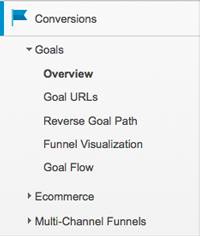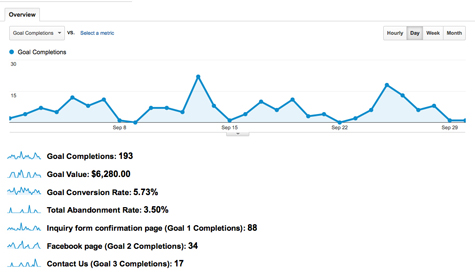
Okay, now that you’re up to speed on a goal-driven approach to web analytics for content analysis, let’s look under the hood of Google Analytics to see how you can track those killer success metrics (KPIs) you defined.
There are many important steps involved in configuring Google Analytics — or any other web analytics tool — to properly record, organize and label data. However, defining your analytics goals is probably the single most important step of your configuration process.
Why? Because you need analytics goals to assess whether your content goals are being met and visitors are taking the actions you want them to. Ultimately, that’s the purpose of web analytics.
When users meet one of your web analytics goals, it contributes to your conversion rate. A 5% conversion rate means 5% of visitors took the action (or actions) you defined and wanted them to take. Nice to know, right?
Types of Web Analytics Goals
For starters, in Google Analytics, there are four types of web analytics goals that can be configured for tracking.
| Google Analytics Goal Types | |
|---|---|
| URL Destination: | Goal completed when visitor views defined URL |
| Visit Duration: | Goal completed when visitor spends X amount of time on site |
| Page/Visit: | Goal completed when visitor views X number of pages on site |
| Event: | Goal completed when visitor takes a predefined action |
If you’re tracking conversions, you will likely be using the URL destination or event goal type, as these types can more easily track specific user actions. As such, I’m going to focus on the two of these for the purposes of this discussion. Visit duration and page/visit are considered "engagement metrics" and are less useful for measuring user actions.
Let’s look at some examples of how these analytics goals track conversions.
| Sample Analytics Goals | |
|---|---|
| Download a PDF: | Brochure, student handbook |
| View specific webpage: | Application confirmation, login page, event registration |
| Complete a form: | Feedback form, inquiry form, newsletter sign-up form |
| Visitor engagement: | Add a blog comment, complete a survey, rate an article |
If these analytics goals were yours, anytime someone downloaded a student handbook PDF, registered for an event, submitted an inquiry form or added a blog post comment, that would get recorded as a completed goal in Google Analytics and contribute to your conversion rate.
Want to know if your content works? Look at those completed goals. Boo-ya!
Configuring Web Analytics Goals
Okay, this is the technical part. I’m not going to dig into the configuration process because there are already numerous tutorials online about how to set up goals in Google Analytics. Here are few I recommend:
- Set up Goals
- Google Analytics in Depth: Goals and Funnels
- 4 Google Analytics Goal Types That Are Critical To Your Business
For additional instruction on configuring Google Analytics goals (as well as other configuration steps), I recommend the following books, which dig deep on the tech side of Google Analytics:
- “Google Analytics” by Justin Cutroni
- “Advanced Web Metrics with Google Analytics, 3rd Edition” by Brian Clifton
If you’re still stuck on configuring goals in Google Analytics, hit me up in the comments below. I’m happy to answer questions or point you to additional resources.
Also, good news! If you have already defined your content goals and success metrics, the hard part is over. Setting up goals in Google Analytics is wicked easy.
Note: Setting up Google Analytics goals requires an administrator account. There are two levels of user access in Google Analytics: Administrator and User. If you don’t have an Administrator account, talk to your Google Analytics account manager and request permission or use this post to make informed requests regarding the configuration of your Google Analytics profile(s). Because goals will affect your overall conversion rate in Google Analytics, it is recommended that you apply them to a test profile first to ensure data reports as expected before updating your active profile(s).
Yay! Analytics Goals! Now What?
Congratulations, you have just established relevant web metrics. Instead of evaluating content based on generic metrics such as pageviews and bounce rates, you have defined metrics that directly relate to your content goals. Did someone take the action you wanted them to? Yes or no? Now you know.
Of course, even conversion metrics need context. As I discussed in my last post on a web analytics framework, there are two additional planning steps that you need to establish proper context and define success: targets and segments. You can revisit that post for detailed descriptions, but here’s a quick recap.
- Goal targets
To make conversion metrics — such as goal completions and conversion rate — meaningful, define goal targets. Is 5% a good conversion rate or a bad one? You decide. - Goal segments
To provide adequate context and actionable content insights, segment traffic according to relevant visitor attributes. How are people converting? Who is converting? When are they converting?
Google Analytics Goal Reports
In an upcoming post, I’m going to share some methods for assessing content goals with Google Analytics, but here are a few things you can do right now to see your content goals in action.
Google Analytics includes a set of standard reports for conversions, including reports on your analytics goals. These allow you to easily view goal completions, goal values, goal conversion rates and goal abandonment rates, and provide a good starting point for tracking goals.
Goals Overview
The Goals Overview report shows you goal completions for all goals included in your Google Analytics profile, including total goal completions.
In this instance, there were 193 total goal completions, representing a 5.73% conversion rate. You can see how many goal completions there were for each goal.
Goal URL
The Goal URLs report shows you what page a goal was completed on. If you have a goal set up for admission email links, this report will show you what page users clicked on the link from.
Reverse Goal Path

The Reverse Goal Path shows you the last three pages users visited before completing a goal. For example, maybe someone visited your MBA program page, then looked at a student profile, then completed your online inquiry form (your defined goal). The better you understand the factors contributing to completed goals, the better you can create content that meets users’ needs.
Funnel Visualization
If you created a funnel for one or more goals (see sources above for a description of goal funnels), you can see an overview of where people drop off before completing a goal. For example, if there is a three-step (three-page) online event registration process, this report will show how many people abandon the process on page 1 and page 2 and how many people reached page 3 and completed the goal.
Goal Flow
The last standard goal report is Goal Flow. Here, you can see a visualization of traffic flow that leads to conversions. For example, you see what sources, mediums, geographic locations or defined Google Analytics events led users to complete a goal.
Finding Actionable Insights
The Google Analytics standard conversion reports open the door for us, but making data useful is all about context. It’s about presenting the right data to the right people based on their business objectives and content goals. We’re going to cover custom reports in our upcoming discussion of methods for assessing content goals. So, stay tuned.
In the meantime, we’d love to hear how you track content goals using web analytics. Or, hit us up with questions.


If some one wishes expert view about blogging then i advise him/her to
pay a quick visit this webpage, Keep up the good work.
I have read many data science posts online previously, but none has managed to captivate my attention like this one. This is truly a masterpiece, and a perfect guide for all data science aspirants. Thanks to the writer for spelling out the concepts clearly, and using just the right words and structure.data science course in KL
Excellently well-written blog! Would appreciate the efforts that you have put into writing this informative post. I hope to see more posts and articles on this website. Thanks for sharing more information about different types of courses like artificial intelligence training, data science, and business analytics. Training from topmost institutions like 360DigiTMG provides guaranteed placement support and practical exposure to the field from the experienced faculty. I enjoyed the post a lot, and I hope other readers will also get the guidance that they need to excel and master the domain of data science or data analytics. Do keep us informed and updated by writing more articles like this.full stack developer course
This article is so awesome and evokes your interest and curiosity about the field of data science for business analytics and artificial intelligence. Analytics and data science certification from 360DigiTMG is of immense help for students who want to make a lucrative career for themselves and become a part of this growing field. The article writer has covered several details, concepts, and ideas about data science and analytics before the readers, along with guaranteed placement support from the faculty of 360DigiTMG. Landing your dream job will be easier for you after reading this article.data science course in KL
Nicely put together and useful for web designers exactly what we share in our community feel free to check us out here.